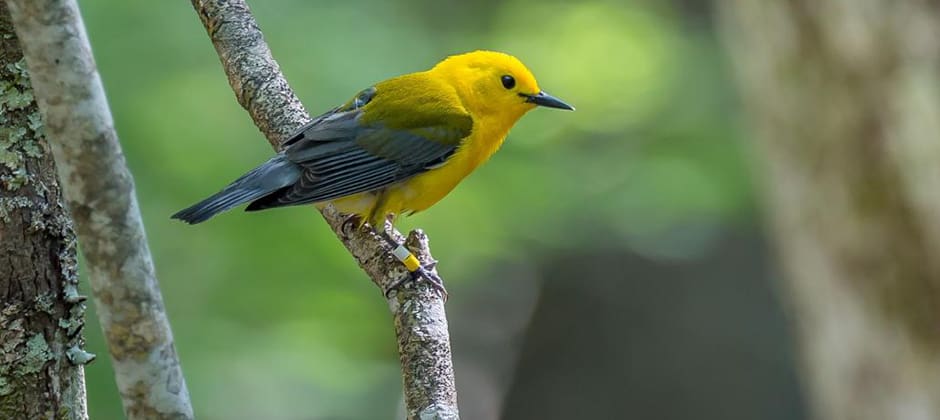Share this article
For declining warblers, winter brings most to same spot
After placing geolocators on prothonotary warblers (Protonotaria citrea) in a number of states, researchers found that wherever the birds depart from, most travel to northern Colombia for the winter.
“This was a big surprise,” said Christopher Tonra, an assistant professor of avian wildlife ecology at Ohio State University and lead author of a recent study published in The Condor: Ornithological Applications. Previous research even suggested they were going to different areas to winter. “We weren’t expecting that they would all go to the same place,” he said.
Tonra and his colleagues with the Prothonotary Warbler Working Group fitted geolocators on 149 birds, which use light sensors to record the time of dawn and dusk and estimate the longitude and latitude of birds’ locations. The birds that carried the devices came from throughout their breeding range.
While some birds died and other trackers no longer worked when they returned, the team was able to collect data from 34 devices.
Although a couple overwintered in Venezuela and Panama, Colombia was the main overwintering site, This means that conservationists can target their efforts in one place, Tonra said, although that place has its challenges. With the end of Colombia’s civil war came increased development, bringing deforestation that could affect the warblers.
The researchers were also surprised by other data from the geolocators. They determined the birds were spending 20 days to a month at stopover sites in locations such as Nicaragua, Honduras and the Yucatan Peninsula. That was much longer than the usual stopover, which often lasts just five to seven days — enough time to refuel, rest and recover. They also found the birds appeared to winter in inland areas instead of the coastal mangroves that researchers previously thought they relied on.
This information is important, Tonra said, in order to know where to implement conservation measures. “We are starting to do some work on the ground in these countries,” he said. But there are some challenges with using geolocators. “One of the limitations with the tags is they’re not very precise and just give a general area, so we don’t know the specifics of what habitats or sites they’re using,” he said.
Meanwhile, Tonra said there’s work conservationists can do at home to benefit the species in their breeding grounds. The warblers are cavity nesters and benefit from nest boxes, he said. Protecting their habitat is also important.
“Habitat preservation and restoration is the biggest ways they can be benefited,” he said. “Keeping that wet forest on the landscape. They also match the habitat needs for game bird species, especially wood ducks. There’s a double conservation benefit to managing a game and nongame species that can benefit from those habitats on the landscape.”
Header Image: Researchers found most prothonotary warblers winter in northern Colombia, where they face increasing threats from deforestation and development. ©Joan Eckhardt








